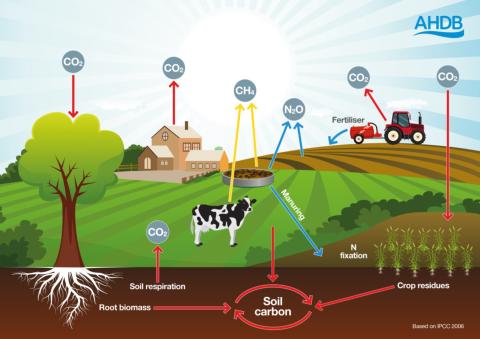Farmers are being asked to manage and deliver multiple public goods on behalf of the nation. As well as producing nutritious and affordable food, they are also asked to improve soil health and fertility, reduce emissions, accelerate carbon sequestration (both above and below ground), improve water and air quality and optimise biodiversity.
These pages look at carbon – both emissions and sequestration. However, carbon should not be considered in isolation, as it is one part of the tapestry of public goods farmers provide.
Net Zero
The aim of the UK and the agriculture industry is to reach Net Zero greenhouse gas emissions. This is where the sum of emissions is equal to the sum of sequestration. The aim is to reach this target as an industry, rather than forcing every farmer to reach net zero as individuals. Some farms will be able to go beyond net zero, while others may find it more challenging.
Additionally, carbon balance is just one aspect of how agriculture interacts with the environment. To enable farmers to provide public goods like affordable food, carbon removals and nature recovery, a whole environment approach must be adopted.
Legislation and targets
In domestic legislation, the 2019 amendment to the Climate Change Act 2008 set the target of Net Zero by 2050. This is in line with the 2015 Paris Agreement, an international agreement to keep global warming well under 2°C and ideally to 1.5°C.
To achieve this, our land-based industries can contribute strongly by adopting new practices both to reduce emissions and to sequester carbon from the atmosphere.
The role of data
Data is very important for understanding what’s happening – as the saying goes, if you can’t measure, you can’t manage. The science around greenhouse gases is complex.. Most carbon footprints are based on international averages (Tier 1 factors) for sequestration and national averages (Tier 2 factors) for emissions. Ideally actual on farm data (Tier 3) would be preferential to provide detailed individual footprints rather than use averages.
The current approach works for the big picture but it does not provide a full reflection of what’s happening on farm. Going forwards it is vital that data specific to UK farms is available. AHDB is calling for an independent, comprehensive baseline to be created at the individual farm business level, which is then given back to the farmer and used to empower better quality decision making on farm. The baseline should be re-measured on a regular basis, so that the actual good work farmers are doing is evidenced, recognised and rewarded. This data can also be used to provide tier 3 factors, improving the accuracy of future greenhouse gas modelling.
In the meantime, AHDB still encourages farmers to calculate their carbon balance, through a calculator or through more comprehensive measurements if possible. It is important to have an individual farm baseline to show progress against. Additionally, all sequestration and emissions-reducing activities should be recorded. This will help farmers prove their provision of public goods and get rewarded for it.



